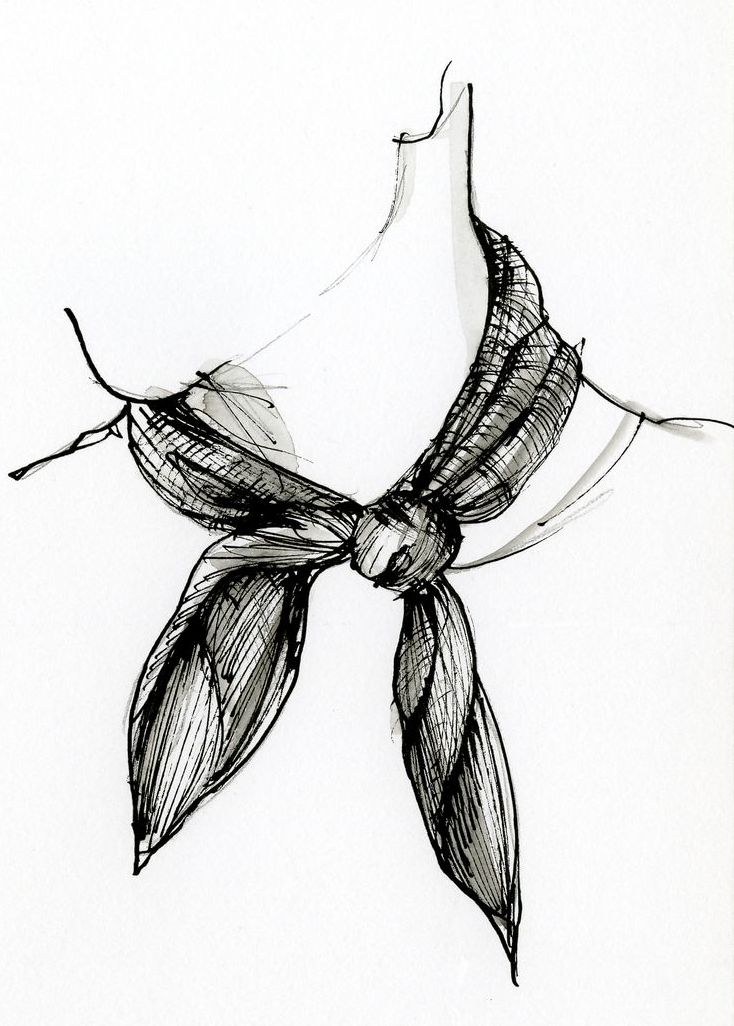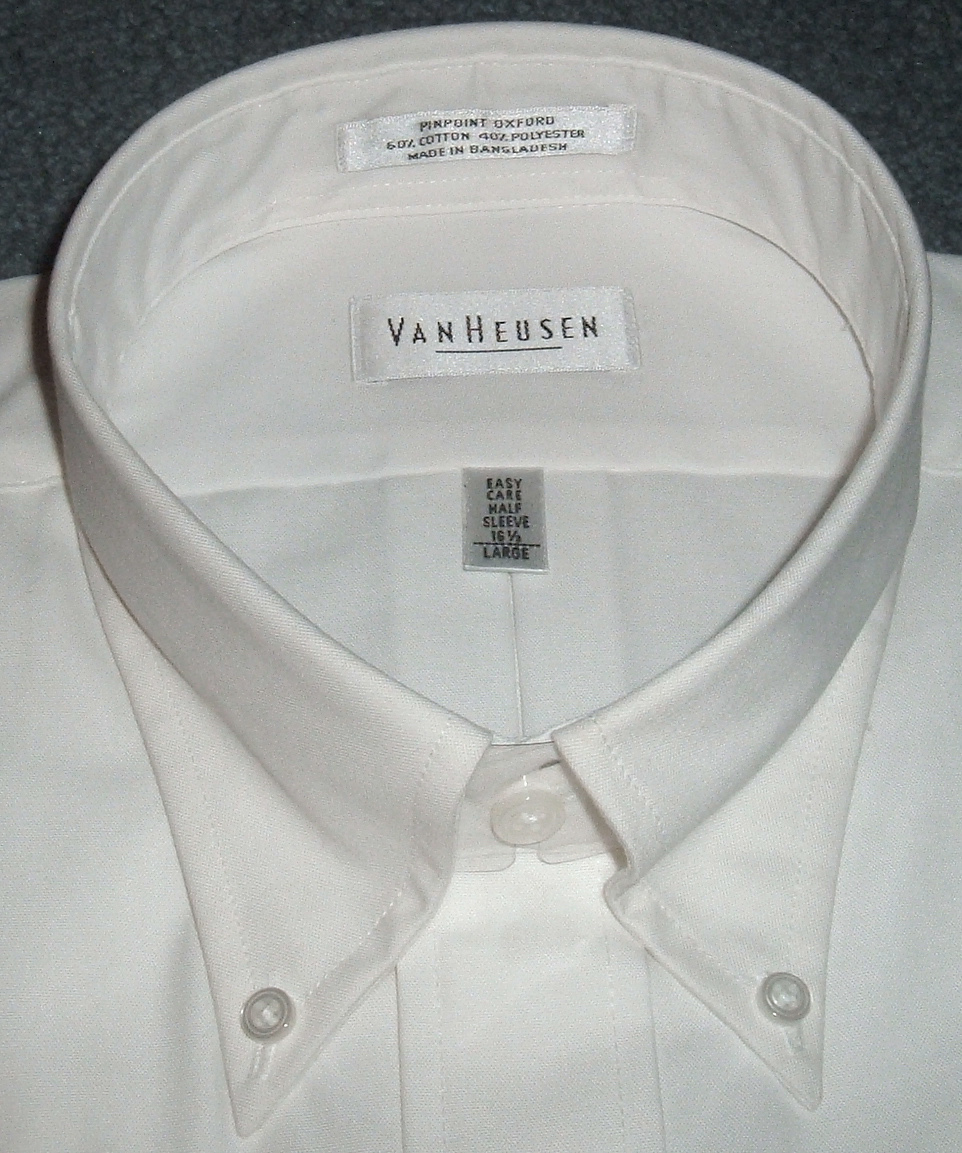|
Necktie
A necktie, long tie, or simply a tie, is a cloth article of formal neckwear or office attire worn for decorative or symbolic purposes, resting under a folded shirt collar or knotted at the throat, and usually draped down the chest. On rare occasions neckties are worn above a winged shirt collar. However, in occupations where manual labor is involved, the end of the necktie is often tucked into the button line front placket of a dress shirt, such as the dress uniform of the United States Marine Corps. Neckties are usually paired with suit jackets or sport coats, but have often been seen with other articles, such as v-neck sweaters. Neckties are reported by fashion historians to be descended from the regency era cravat. Adult neckties are generally unsized in length but may be available in a longer sizes for taller persons. Widths are matched to the width of a suit jacket lapel. Neckties were originally considered " menswear," but are now considered unisex items in most We ... [...More Info...] [...Related Items...] OR: [Wikipedia] [Google] [Baidu] |
Neckwear
Neckwear is a category of clothing that is worn around or on the neck. Neckwear can be Utilitarian design, utilitarian in nature, usually to protect the neck from colder temperatures, or can be worn as a "fashion statement." Neckwear is distinguishable from a necklace, which is defined as Jewellery, jewelry. Types of neckwear Neckerchief A neckerchief (from ''neck'' (n.) + ''kerchief''), sometimes called a necker, kerchief or scarf, is a type of neckwear associated with those working or living outdoors, including Farmer, farm labourers, cowboys and sailors. It is most commonly still seen today in the Scouts, Girl Guides and other similar youth movements. A neckerchief consists of a triangular piece of cloth or a rectangular piece folded into a triangle. The long edge is rolled towards the point, leaving a portion unrolled. The neckerchief is then fastened around the neck with the ends either tied or clasped with a slide or woggle. Scarf A scarf (pl.: scarves or scarfs) ... [...More Info...] [...Related Items...] OR: [Wikipedia] [Google] [Baidu] |
Dress Shirt
A dress shirt, button shirt, button-front, button-front shirt, or button-up shirt is a garment with a Collar (clothing), collar and a full-length opening at the front, which is fastened using buttons or shirt studs. A button-down or button-down shirt is a dress shirt with a button-down collar – a collar having the ends fastened to the shirt with buttons. A dress shirt is normally made from woven cloth, and is often accompanied by a Necktie, tie, jacket, suit (clothing), suit, or formalwear, but a dress shirt may also be worn more casually. In British English, "dress shirt" ("formal shirt" or "tuxedo shirt" in American English) means specifically the more formal evening garment worn with black tie, black- or white tie, white-tie. Some of these formal shirts have stiff fronts and detachable collars attached with collar studs. History Traditionally dress shirts were worn by men and boys, whereas women and girls often wore blouses, sometimes known as chemises. However, in the ... [...More Info...] [...Related Items...] OR: [Wikipedia] [Google] [Baidu] |
Shirt Collar
In clothing, a collar is the part of a shirt, dress, coat (clothing), coat or blouse that fastens around or frames the neck. Among clothing construction professionals, a collar is differentiated from other necklines such as revers and lapels, by being made from a separate piece of fabric, rather than a folded or cut part of the same piece of fabric used for the main body of the garment. A collar may be permanently attached to the main body of the garment (e.g. by stitching) or Detachable collar, detachable. Word usage The Oxford English Dictionary traces ''collar'' in its modern meaning to c. 1300, when collars served as gorget, neck-protecting armour. History Today's shirt collars descend from the rectangular band of linen around the neck of 16th century shirts. Separate ruffs exist alongside attached ruffled collars from the mid-16th century, usually to allow starching and other fine finishing, or to make collar-laundering easier.Compare: During the medieval period and ... [...More Info...] [...Related Items...] OR: [Wikipedia] [Google] [Baidu] |
Winged Collar
In clothing, a collar is the part of a shirt, dress, coat or blouse that fastens around or frames the neck. Among clothing construction professionals, a collar is differentiated from other necklines such as revers and lapels, by being made from a separate piece of fabric, rather than a folded or cut part of the same piece of fabric used for the main body of the garment. A collar may be permanently attached to the main body of the garment (e.g. by stitching) or detachable. Word usage The Oxford English Dictionary traces ''collar'' in its modern meaning to c. 1300, when collars served as neck-protecting armour. History Today's shirt collars descend from the rectangular band of linen around the neck of 16th century shirts. Separate ruffs exist alongside attached ruffled collars from the mid-16th century, usually to allow starching and other fine finishing, or to make collar-laundering easier.Compare: During the medieval period and sporadically thereafter, people wore o ... [...More Info...] [...Related Items...] OR: [Wikipedia] [Google] [Baidu] |
Cravat (early)
The cravat () is a neckband, the forerunner of the modern tailored necktie and bow tie, originating from a style worn by members of the 17th century military unit known as the Cravats. The modern British "cravat" is called an "ascot" in American English. From the end of the 16th century, the term ''band'' applied to any long-strip neckcloth that was not a ruff. The ruff, a starched, pleated white linen strip, originated earlier in the 16th century as a neckcloth (readily changeable, to minimize the soiling of a doublet), as a bib, or as a napkin. A band could be either a plain, attached shirt collar or a detachable "falling band" that draped over the doublet collar. It is possible that initially, cravats were worn to hide soil on shirts. History According to 1828 encyclopedic ''The art of tying the cravat: demonstrated in sixteen lessons'', the Romans were the first to wear knotted kerchiefs around their necks, but the modern version of the cravat (French: ''la cravate'') ... [...More Info...] [...Related Items...] OR: [Wikipedia] [Google] [Baidu] |
Uniform
A uniform is a variety of costume worn by members of an organization while usually participating in that organization's activity. Modern uniforms are most often worn by armed forces and paramilitary organizations such as police, emergency services, security guards, in some workplaces and schools, and by inmates in prisons. In some countries, some other officials also wear uniforms in their duties; such is the case of the Public Health Service Commissioned Corps, Commissioned Corps of the United States Public Health Service or the France, French préfet, prefects. For some organizations, such as police, it may be illegal for non-members to wear the uniform. Etymology From the Latin ''unus'' (meaning one), and ''forma'' (meaning form). Variants Corporate and work uniforms Workers sometimes wear uniforms or corporate clothing of one nature or another. Workers dress code, required to wear a uniform may include retail workers, bank and post-office workers, public security, pu ... [...More Info...] [...Related Items...] OR: [Wikipedia] [Google] [Baidu] |
Menswear
Fashion is a term used interchangeably to describe the creation of clothing, footwear, Fashion accessory, accessories, cosmetics, and jewellery of different cultural aesthetics and their mix and match into Clothing, outfits that depict distinctive ways of dressing (Style (visual arts), styles and trends) as signifiers of social status, Self-expression values, self-expression, and group belonging. As a multifaceted term, fashion describes an Clothing industry, industry, fashion design, designs, Aesthetics (textile), aesthetics, and trends. The term 'fashion' originates from the Latin word 'Facere,' which means 'to make,' and describes the manufacturing, mixing, and wearing of outfits adorned with specific cultural aesthetics, patterns, motif (textile arts), motifs, shapes, and cuts, allowing people to showcase their group belongings, values, meanings, beliefs, and ways of life. Given the rise in mass production of Commodity, commodities and clothing at lower prices and global rea ... [...More Info...] [...Related Items...] OR: [Wikipedia] [Google] [Baidu] |
Croats (military Unit)
The Croats, also known as Cravats or Crabats, were 17th-century light cavalry forces in Central Europe, comparable to the hussars. The Croats were initially irregular units loosely organized in bands. The first regular Croat regiment was established in 1625. The most notable engagement of the Croats was their participation on the Habsburg side in the Thirty Years' War, serving in the Imperial Army or within the troops of the Catholic League. At the height of the Thirty Years' War, as many as 20,000 Croatian cavalry were in the service of the Imperial Army, including the majority of Wallenstein's harquebusiers. The name came to be used as a generic term for light cavalry from the area of the Habsburg Military Frontier rather than an ethnic designation, and included ethnic Croats, Hungarians, Serbs, Wallachians, Poles, Cossacks, Albanians and Tatars. Initial structure The Croats were initially recruited by generals of the Habsburg monarchy. The soldiers who joined Croats ... [...More Info...] [...Related Items...] OR: [Wikipedia] [Google] [Baidu] |
Croatia
Croatia, officially the Republic of Croatia, is a country in Central Europe, Central and Southeast Europe, on the coast of the Adriatic Sea. It borders Slovenia to the northwest, Hungary to the northeast, Serbia to the east, Bosnia and Herzegovina and Montenegro to the southeast, and shares a maritime border with Italy to the west. Its capital and largest city, Zagreb, forms one of the country's Administrative divisions of Croatia, primary subdivisions, with Counties of Croatia, twenty counties. Other major urban centers include Split, Croatia, Split, Rijeka and Osijek. The country spans , and has a population of nearly 3.9 million. The Croats arrived in modern-day Croatia, then part of Illyria, Roman Illyria, in the late 6th century. By the 7th century, they had organized the territory into Duchy of Croatia, two duchies. Croatia was first internationally recognized as independent on 7 June 879 during the reign of Duke Branimir of Croatia, Branimir. Tomislav of Croatia, Tomis ... [...More Info...] [...Related Items...] OR: [Wikipedia] [Google] [Baidu] |
Neckerchief
A neckerchief (from ''neck'' (n.) + ''kerchief''), also kerchief, scarf, and bandana, is a type of neckwear associated with those working or living outdoors, including farm labourers, cowboys and sailors. It is most commonly still seen today in the Scouts, Girl Guides and other similar youth movements. A neckerchief consists of a triangular piece of cloth or a rectangular piece folded into a triangle. The long edge is rolled towards the point, leaving a portion unrolled. The neckerchief is then fastened around the neck with the ends either tied or clasped with a slide or woggle. History Terracotta Army The figures of the Terracotta Army, dating from the 3rd century BCE, are notable for prominently featuring neckerchiefs, as each of the approximately 7,500 statues is depicted wearing one. This detail is particularly unusual, as no comparable artistic or sculptural evidence of neck cloths appears in Chinese or other world cultures for many centuries thereafter. Contemporary Chi ... [...More Info...] [...Related Items...] OR: [Wikipedia] [Google] [Baidu] |
Dress Uniform
Full dress uniform, also known as a ceremonial dress uniform or parade dress uniform, is among the most formal wear, formal type of uniform used by military, police, firefighter, fire and other public uniformed services for official parade (military), parades, ceremonies, and receptions, including private ones such as marriages and funerals. Full dress uniforms typically include full-size order (distinction), orders and medals insignia. Styles tend to originate from 19th-century uniforms, although the 20th century saw the adoption of mess dress uniform, mess dress-styled full-dress uniforms. Designs may depend on regiment or service branch (e.g. army, navy, air force, marines). In Western dress codes, full dress uniform is a permitted supplementary alternative equivalent to the civilian white tie for evening wear or morning dress for day wear – sometimes collectively called ''full dress'' – although military uniforms are the same for day and evening wear. As such, full dress u ... [...More Info...] [...Related Items...] OR: [Wikipedia] [Google] [Baidu] |
Paris
Paris () is the Capital city, capital and List of communes in France with over 20,000 inhabitants, largest city of France. With an estimated population of 2,048,472 residents in January 2025 in an area of more than , Paris is the List of cities in the European Union by population within city limits, fourth-most populous city in the European Union and the List of cities proper by population density, 30th most densely populated city in the world in 2022. Since the 17th century, Paris has been one of the world's major centres of finance, diplomacy, commerce, culture, Fashion capital, fashion, and gastronomy. Because of its leading role in the French art, arts and Science and technology in France, sciences and its early adoption of extensive street lighting, Paris became known as the City of Light in the 19th century. The City of Paris is the centre of the Île-de-France region, or Paris Region, with an official estimated population of 12,271,794 inhabitants in January 2023, or ... [...More Info...] [...Related Items...] OR: [Wikipedia] [Google] [Baidu] |











